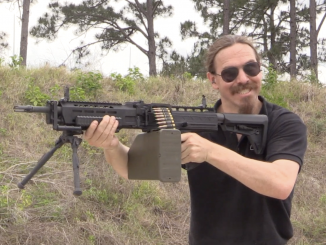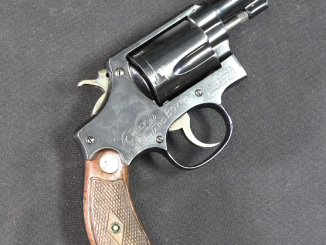Today I am shooting a Colt 1908 originally issued to the Shanghai Municipal Police in 1925. The gun was chosen for issue by William Fairbairn, who is best known for training OSS and SOE operatives in hand-to-hand combat techniques during World War Two. Fairbairn worked for the Shanghai city government modernizing and running their police department in the 1920s and 1930s; one of the most violent and dangerous cities in the work at the time. He chose the 1908 Colt Pocket Hammerless for his Chinese officers, complete with a few custom modifications.
Frankly, the Colt 1908 is a fantastic pistol. I had a great time shooting this one today – it was flawlessly reliable, accurate, and fast. What more can you ask? You can see my full video on the SMP version of the Colt (not this exact gun) here:
General Rules for the B.U.G. Match:
Score is points minus time. Time is recorded as the number of full seconds only (ie, 5.75 seconds is scored as 5). All targets are worth up to 7 points. Steel that falls is full score, and 3 points per hit that does not cause it to fall. Paper targets are worth 7 in the head, 5 in the A zone, 3 in the C zone, and 1 in the D zone. Shoot as much or as little as you like; no penalties for missing or not engaging.




How did you do score wise vs. the rest of the shooters?
Nice shooting in the BUG match. Afterwards I watched the RIA video on the 1908 from five years ago. I had forgotten about the old musical intro with the montage, I think you should bring that back, just my opinion.
“(…)old musical intro with the montage(…)”
[OFF-TOPIC SO IGNORE IF YOU WISH]
Can we reactive Vintage Saturday, maybe in more limited size if photo resources are too thin for every week (once in month)?
(I was reading recently one article on topwar about BTR-40:
https://topwar.ru/164236-btr-40-pervyj-sovetskij-serijnyj-bronetransporter.html
and one photo /first from top/ reminded me about Vintage Saturday)
I MISS VINTAGE SATURDAY (intentional caps)
As a pleased owner of a 1908 Colt I can report that after about 150+ rounds of ball ammo plus various hollow points I really love shooting and handling it. Yes, it’s big and heavy from being all steel, but when in the hand it feels more “serious” than any pocket .380’s or 9mm’s made today. I realize that’s all subjective emotionalism, but it really feels good in an inside the pants holster. My only criticism is that it has a split feed ramp like its son the 1911, so some brands of ammo with sharp edged bullets may hang up on that split. Well, I’m off to raid some bootleg joint with my pocket hammerless. By by.
1) OMG !t’s Dangerous Dan’s own personal pistol !!!.
https://en.wikipedia.org/wiki/William_E._Fairbairn
2) Have a genuine issue Sykes-Fairbairn dagger that I got through some devious trading with a member of the Queen’s forces back in the Eighties when stationed in Germany. Each RM Commando is awarded his knife on graduation and it is so iconic, it is part of their insignia.
https://www.knifecenter.com/item/IXSF71490/sheffield-fairbairn-sykes-british-commando-dagger-black
and
https://www.wyedeanstores.com/rm-royal-marines-commando-trained-officers-soldiers-qualification-machine-embroidered-badge-commando-dagger
Goes along with my Gurkha Kukri and my copy of Fairbairn’s book “Get Tough”.
3) The opening scenes of “Indiana Jones and the Temple of Doom” are set in a comic book version of 1930’s Shanghai.
For a look at the Shanghai Police and their flying squad read Robert Bickers’ ‘Empire Made Me.’ The tone is prissily politically correct, but it features a lot of incidents and anecdotes.
I don’t have my copy of ‘Shooting to Live with the One-Hand Gun’ at hand. But as I recall, Fairbairn did encourage two-hand shooting with careful sighting…but only when there was time and/or cover to do so.
I THINK I recall him writing that he disabled the grip safeties on the 1911’s that were issued to Russian and ‘European’ officers. The book includes a LOT of details about rotating ammunition stores, the original ‘Hogan’s Alley’ style shooting course, and periodically checking and maintaining spare magazines…which he seemed to accept would be stuffed into pockets without protection.
It is a terrific book, and I think it can be found online without too much trouble.
May I inquire what holster is that? I want one. As a fellow lefty.
Fairburn’s book ‘Shooting to live’ is free to read here: https://archive.org/details/ShootingToLiveWilliamFairbairn
It is a quick read at just over a hundred pages, and is of genuine interest to anyone who watches this channel. It names only a few specific gun types but says a vast amount about pistols and their usage in clear and concise language. For instance he reports 2 instances when a ‘criminal’ was shot with several Webley .455 bullets and both then had to be hit with the butt to put them down! He then experimented on bullet force on target by having someone fire all kinds of bullets at a bullet proof shield he was holding!
On another level 2 gun action challenge is a rediscovery/invention of his suggested training ethos; apart from his refusal to reward ‘good’ scores. His aim was to make all his officers good enough in all possible circumstances; and give them enough challenging practise to keep them that way.
Regarding magazine disconect safeties, I could not agree more, and have performed this operation 3 times on Zastava m57s.
After reading the 1942 classic “Shooting to Live” several decades ago, the reason for extra witness holes in SMP magazines should be obvious: a perception that positive control of ammunition was required in order to prevent pilferage. There were many ways to do this and SMP did two of them:
1) limited ammunition supply to just two magazines with 12 live cartridges
2) drilled extra witness holes so that the primers and projectiles were visible
I am an experienced military armorer and spent five years as an anti-terrorist security contractor in the Middle East: accounting for arms and ammunition to ensure that none went missing (and wound up in hostile hands) could have been done by unloading all magazines and then inspecting each loaded cartridge. That would eat into shift change time. With reliable and trusted personnel, the 5, 10 and 15 round witness holes in the Beretta M9 pistol magazine were enough–and a fully-loaded M16 magazine will look and feel different from a partially-loaded M16 magazine. The third issue weapon I had on contract was the M60 machine gun.
The SMP modified magazines allowed detecting at a glance if a spent casing had been substituted for the live cartridge. Extra holes in Thompson submachine gun magazines would have been counter-productive due to ingress of dust and debris, but for pistol magazines kept in the pistol or in a magazine case, the magazine and cartridges would be protected. Reading “Shooting to Live” made me doubt that magazine cases were issued to SMP officers.
Another good information source is Leroy Thompson’s book below:
https://www.barnesandnoble.com/w/the-worlds-first-swat-team-leroy-thompson/1111710506